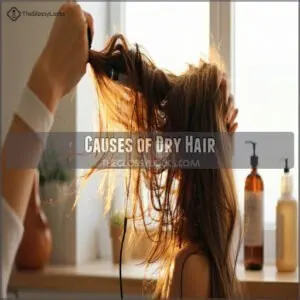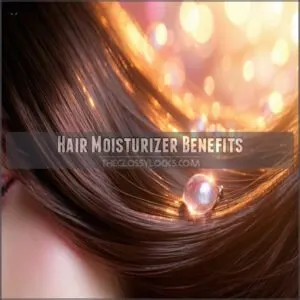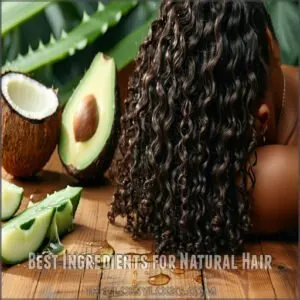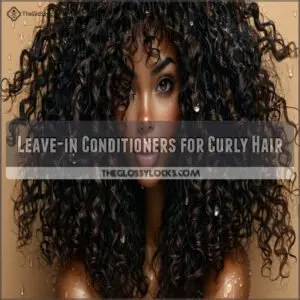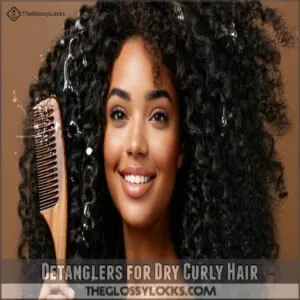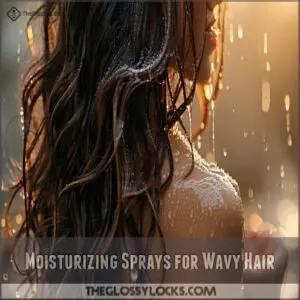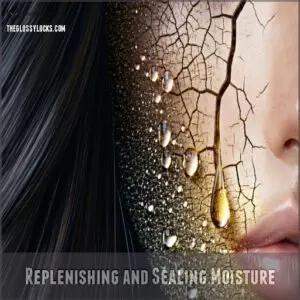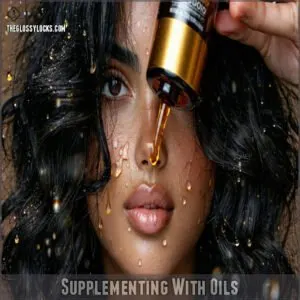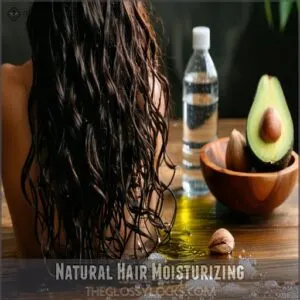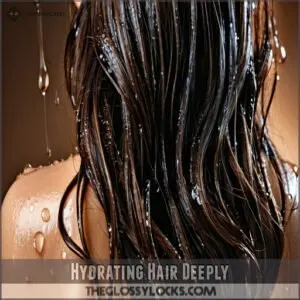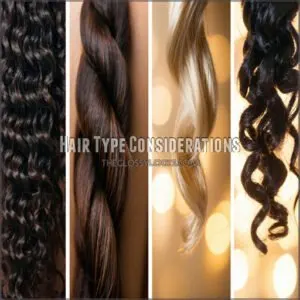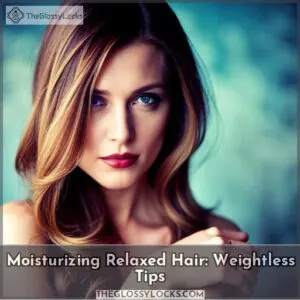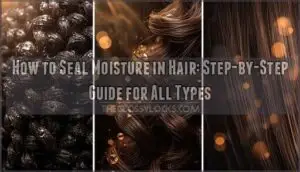This site is supported by our readers. We may earn a commission, at no cost to you, if you purchase through links.
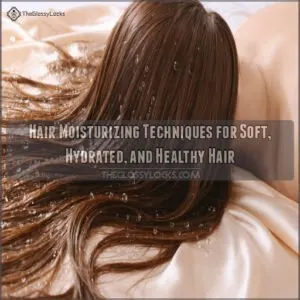 Mastering hair moisturizing techniques is the secret to soft, hydrated locks that feel as good as they look.
Mastering hair moisturizing techniques is the secret to soft, hydrated locks that feel as good as they look.
Start by understanding your hair’s porosity—low porosity needs lightweight products, while high porosity thrives on thicker creams and oils.
Use water as a base moisturizer, then seal it in with natural oils like argan or jojoba.
Don’t skip leave-in conditioners; they’re lifesavers for curly or dry hair.
Limit heat styling and always use a protectant if you can’t resist your flat iron.
Deep conditioning masks and satin pillowcases also work wonders.
Ready to transform your routine? There’s more to explore for every hair type!
Table Of Contents
- Key Takeaways
- Causes of Dry Hair
- Hair Moisturizer Benefits
- Choosing Hair Moisturizer
- Moisturizing Techniques
- Natural Hair Moisturizing
- Hydrating Hair Deeply
- Hair Type Considerations
- Maintaining Moisturized Hair
- Frequently Asked Questions (FAQs)
- What are the best ways to moisturize hair?
- How do I rehydrate my hair?
- How can I deep moisturize my hair naturally?
- What hydrates hair the most?
- How does diet impact hair moisture levels?
- Can stress contribute to dry hair issues?
- What role does scalp health play in hydration?
- Are there specific vitamins for hair moisture?
- How does water quality affect hair dryness?
- Conclusion
Key Takeaways
- Understand your hair’s porosity to choose the right products—lightweight for low porosity and thicker creams for high porosity.
- Use water as a base moisturizer, seal it with natural oils like argan or jojoba, and don’t skip leave-in conditioners.
- Limit heat styling, always use a protectant, and try heatless methods to prevent moisture loss.
- Sleep on satin pillowcases, deep condition weekly, and drink plenty of water to maintain hydration.
Causes of Dry Hair
Dry hair happens when your strands lose moisture faster than they can retain it.
Factors like hair porosity, reduced sebum production, environmental stress, and heat styling often leave your hair feeling parched and brittle.
Hair Porosity Issues
Hair porosity is all about how your hair absorbs and retains moisture.
Low porosity hair repels water, making hydration tricky, while high porosity hair absorbs moisture but struggles to hold it.
Medium porosity strikes a balance.
Porosity tests, like the float test, reveal your type.
Damaged cuticles and moisture imbalance can disrupt scalp health, leaving hair thirsty and brittle.
Lack of Sebum Production
Sometimes, your sebaceous glands don’t produce enough sebum, leading to a dry scalp and moisture imbalance.
This sebum deficiency can cause dryness and brittle strands.
To combat this, use natural hair moisturizers like argan or jojoba oil to restore moisture balance.
Regularly applying these hair oils helps seal hydration, keeping your hair soft, healthy, and manageable.
Environmental Factors
Living in harsh environmental conditions can leave your hair parched.
Climate change intensifies UV exposure, while air pollution and poor water quality strip moisture, causing dryness.
Exposure to these elements can increase hair porosity issues.
Humidity control becomes tricky, leading to frizz or flatness.
Protect your strands from environmental damage with UV protection sprays and hydrating masks.
Environmental exposure doesn’t have to win—just arm yourself with the right tools!
Hair Damage From Heat Styling
Switching from environmental stressors to your bathroom counter, heat styling tools can be your hair’s worst enemy.
Excessive use leads to thermal damage, hair breakage, and moisture loss.
Protect your strands with these tips:
- Use a heat protectant spray.
- Limit hot tool use to once a week.
- Opt for lower heat settings.
- Air-dry whenever possible.
- Embrace heatless styling methods.
Hair Moisturizer Benefits
Using a good hair moisturizer isn’t just about keeping your strands soft—it’s a game-changer for overall hair health.
It helps replenish lost moisture, seal the cuticle, and reduce frizz, leaving your hair stronger, shinier, and more manageable.
Replenishing Moisture
When your hair feels like straw, it’s begging for moisture balance.
Start with a hydrating shampoo and conditioner to boost hair hydration. Follow with a leave-in hair moisturizer to target dryness.
Deep conditioning weekly repairs cuticles and locks in softness.
Natural hair oils, like argan or coconut, offer oil therapy while promoting scalp health and restoring vigor.
Sealing Cuticles
Think of your cuticles as tiny gates protecting your hair’s moisture.
Sealing them keeps hydration locked in and strands smooth.
Use these techniques:
- Apply a natural hair oil like argan or jojoba for Oil Sealing.
- Finish with cold water to Hair Smoothen and lock moisture.
- Try Sealant Products like leave-in conditioner or hair serum for added Hair Hydration.
Reducing Frizz
Ever wonder why frizz feels like an endless battle?
It’s all about locking in moisture while smoothing cuticles.
Use a leave-in conditioner or hair serum to tame unruly strands and boost shine.
A hair hydration mask can work wonders, sealing moisture for that silk finish.
Consistent cuticle care keeps your hair smoothen and frizz-free, effortlessly.
Improving Hair Elasticity
Frizz under control? Great! Now, let’s boost your hair’s bounce and resilience with better elasticity.
Proper moisture balance and protein repair are your best friends here.
Try these:
- Use a hair hydration mask weekly for deep moisturizing treatment.
- Test elasticity by gently stretching strands—healthy hair springs back.
- Strengthen with nourishing oils or protein-rich products for lasting flexibility.
Choosing Hair Moisturizer
Choosing the right hair moisturizer can feel like picking a needle out of a haystack, but it doesn’t have to be overwhelming.
Focus on products with nourishing ingredients like shea butter or glycerin to keep your hair soft, hydrated, and manageable.
Best Ingredients for Natural Hair
When choosing moisturizing products for natural hair, focus on ingredients that deliver real hair nourishment.
Natural oils like coconut oil and avocado oil penetrate deeply, while aloe vera locks in hydration.
Hair butters, especially shea moisture, coat strands for lasting softness.
You can find a variety of shea moisture hair products online.
These hydrating hair heroes work wonders, leaving your hair moisturized, manageable, and ready to shine.
Leave-in Conditioners for Curly Hair
For curly hair care, leave-in conditioners are a game-changer.
These moisturizing products lock in moisture, enhance curl definition, and prevent frizz.
Look for lightweight, water-based leave-in products with natural ingredients like glycerin or aloe vera.
You can find a variety of curly hair leave-in conditioner products online.
Apply evenly to damp hair, focusing on ends for better hydration, it’s like giving your curls a drink they’ll thank you for, with a leave-in product that makes a difference.
Detanglers for Dry Curly Hair
Taming dry, tangled curls starts with the right detangler. Look for products with slippery elm or marshmallow root—they’re like a magic wand for knots.
Pair them with leave-in conditioners to boost moisture locking. For specific product recommendations, explore these effective curly hair detanglers.
Detangling tools, like wide-tooth combs, make hair combing smoother and gentler. With these curly hair care essentials, your strands stay hydrated and stress-free!
Moisturizing Sprays for Wavy Hair
For wavy hair care, a leave-in moisturizing spray is your secret weapon.
These sprays deliver quick hair hydration, lock in moisture, and provide frizz control without weighing strands down.
A wide variety of wavy hair moisturizing sprays are available online.
Incorporate one into your moisturizing routine after washing for soft, defined waves.
Look for moisturizing hair products with lightweight ingredients like coconut water or glycerin for best results.
Moisturizing Techniques
Keeping your hair moisturized isn’t just about slathering on products—it’s about using the right techniques to lock in hydration.
From smart shampooing to sealing with oils, these methods guarantee your hair stays soft, healthy, and full of life.
Shampooing Smartly
Starting your moisturizing routine with a sulfate-free shampoo is key.
Opt for gentle cleansing to avoid stripping natural oils. Use warm water—not hot—to maintain your hair’s pH balance.
A scalp massage during shampooing boosts circulation and promotes healthy roots.
On off-days, dry shampoo keeps things fresh without overwashing. Smart shampooing sets the stage for hydrated, healthy hair!
Replenishing and Sealing Moisture
Think of your hair like a sponge—it needs moisture and a seal to stay hydrated.
Here’s how:
- Apply a hydrating product with humectants like glycerin.
- Lock in moisture with a hair serum or natural oil.
- For detailed guidance, explore effective hair moisture sealing techniques.
- Use cool water to close cuticles.
- Balance sebum by avoiding overwashing.
- Focus on cuticle care for lasting hydration.
Using Leave-in Conditioners
Leave-in conditioners are your secret weapon for lasting hydration.
They lock in daily moisture, smooth strands, and reduce frizz without weighing hair down.
Whether you prefer a leavein moisturizing spray or a creamy formula, these products layer seamlessly with your routine.
For best results, apply to damp hair, focusing on the ends—skip the roots for balanced, lightweight care to achieve lasting hydration.
Supplementing With Oils
Adding oils to your routine boosts moisture and shine.
Try these hair moisturizing techniques:
- Apply jojoba oil or argan oil to ends for moisture locking.
- Use hair serums sparingly to tame frizz and add luster.
- Experiment with oil blends like coconut and almond for a DIY hair oil treatment.
- Massage natural oils into damp hair to seal hydration.
Natural Hair Moisturizing
You don’t need a cabinet full of products to keep your hair hydrated—sometimes, nature does the job best.
Using water, natural oils, and avoiding harsh chemicals can work wonders for maintaining soft, healthy hair.
Water as a Moisturizer
Water is the unsung hero of hair hydration.
It’s the foundation of moisture retention, boosting your hair’s moisture level instantly. Aqua therapy, like misting or dampening strands before applying products, locks in hydration effectively.
Incorporating water into your hair moisturizing techniques maintains softness and shine. Remember, hydration methods start with water—your hair’s best friend for natural, healthy moisture.
Frequency of Moisturizing
Consistency is key to a successful hair moisturizing routine.
For balanced moisture levels, adjust your schedule based on your hair type.
Daily hydration with a light leave-in works wonders, while weekly routines like deep conditioning or overnight masks tackle dryness.
A morning serum boosts shine and locks in moisture, and it is essential to tailor your moisture schedules to find the best dry hair remedies, using techniques like deep conditioning and applying a morning serum.
Using Natural Oils
Natural oils are your hair’s best friend for moisture lock.
Coconut oil repairs damage, while olive oil conditions deeply.
Argan oil works wonders for dye-damaged strands, and jojoba oil doubles as a hair serum for thinning hair.
Mix oil blends for natural remedies suited to your needs—hydrating, smoothing, and protecting your hair effortlessly.
Avoiding Harsh Chemicals
You’ve probably heard it before—harsh chemicals are your hair’s worst enemy.
Stick to chemical-free, gentle products for natural hair care.
Here’s how:
- Use sulfate-free shampoos to retain moisture.
- Opt for organic options like natural oils.
- Try a deep conditioning mask weekly.
- Avoid alcohol-based products.
- Explore safe alternatives like natural remedies for styling.
Healthy hair, happy you, with natural hair care and a happy lifestyle.
Hydrating Hair Deeply
When your hair feels dry and lifeless, deep hydration is the key to restoring its softness and strength.
By using techniques like deep conditioning masks and nourishing oils, you can replenish moisture and protect your strands from further damage.
Deep Conditioning Masks
A deep conditioning mask is like a spa day for your hair.
It offers intense hydration, repairs damage, and locks in moisture for softer, healthier strands.
Apply a deep conditioner or hair mask treatment weekly, letting it sit for 20-30 minutes, and focus on the ends for maximum benefits.
These deep treatments are your go-to for hair repair and moisture lock!
Heat Protectants for Hair
Before reaching for that flat iron, grab a heat protectant. Thermal shields, like sprays or styling creams, form a barrier against high temperatures.
Protective oils and serums offer damage repair while locking in moisture. Pairing heat protectants with ionic hair tools reduces frizz and boosts shine.
Want healthier hair? Try heatless hairstyles occasionally to give strands a break.
Hair Oils for Hydration
While heat protectants shield your strands, hair oils for moisturizing take hydration up a notch.
Natural oils like argan, coconut, or jojoba work wonders to lock in moisture and boost shine.
Pair them with hydrating masks or use as a hair serum for added benefits.
Apply sparingly to avoid greasiness—your hair will thank you, and remember to use natural oils.
Regular Trims for Healthy Hair
A regular trim isn’t just a haircut—it’s a reset for your hair health.
Split ends can creep up, stalling hair growth and moisture retention.
Here’s why trims matter:
- Prevent split ends from spreading.
- Promote healthier scalp and strands.
- Keep your hair care routine effective.
- Maintain shape and moisture balance.
Snip smart for hydrated, thriving hair!
Hair Type Considerations
Your hair type plays a big role in how it retains moisture and responds to products.
Whether your strands are curly, wavy, coily, or fine, tailoring your routine to match their unique needs leads to better hydration and healthier hair.
Moisturizing Curly Hair
Curly hair care demands a focus on moisture lock and curl definition.
The spiral shape of curly hair prevents natural oils from reaching the ends, leading to dryness. Use hydrating products like leave-in conditioners and hair serums to seal moisture.
Hair oil benefits include taming frizz and boosting shine. Opt for sulfate-free shampoos and microfiber towels to reduce dryness.
For extra hydration, try weekly deep conditioning treatments—your curls will thank you! You can learn more with this helpful curly hair moisturizing guide to improve your curly hair care routine.
Caring for Wavy Hair
For wavy hair care, hydration is key to enhancing your hair texture and controlling frizz.
Use a lightweight leave-in conditioner to lock in moisture without weighing down waves. A hydrating product like a mist spray works wonders for curl enhancement.
For extra shine, apply a hair serum sparingly. These simple hair care tips will keep your waves nourished and defined.
Hydrating Coily Hair
Coily hair care requires extra love since its spiral shape makes moisture travel a challenge.
Start with hydrating products like a sulfate-free shampoo and rich conditioner. Use a leave-in conditioner and follow up with a hair serum or oil treatments to lock in moisture.
Weekly hydrating masks work wonders for curl revival, keeping your coils soft, shiny, and manageable.
Moisturizing Fine Hair
Fine hair needs a gentle touch.
Opt for lightweight products to avoid weighing it down. Use a gentle shampooing routine and follow up with a leave-in conditioner for daily hydration.
Silk pillowcases are a game-changer, reducing friction and keeping hair soft.
Hydrating products, like sprays or serums, can add shine without buildup, making fine hair manageable and moisturized.
Maintaining Moisturized Hair
Keeping your hair moisturized isn’t just about products—it’s about smart habits that lock in hydration.
From skipping excessive heat styling to using satin pillowcases, small changes can make a big difference in maintaining soft, healthy hair.
Reducing Heat Styling
Cutting back on heat styling is a game-changer for hair repair.
Opt for heatless styling methods like braids or buns to protect strands. Use cold water after washing to seal moisture, and apply hair serums for added shine.
Minimal heating reduces hair damage, while protective styles like twists or updos keep your locks hydrated and healthy, and heatless styling methods are key to this process.
Protecting From Environmental Factors
Shielding your hair from environmental stressors is like giving it armor.
Consider a dry climate hair care routine for extra protection.
Sun protection prevents UV rays from zapping moisture, while a wind shield keeps strands from tangling and breaking.
Use pollution defense sprays to block grime, and embrace protective styling for climate adaptation.
Humidity control products can also tame frizz, ensuring your hair stays hydrated and rejuvenated, rain or shine.
Using Satin Pillowcases
Switching to satin pillowcases is a simple upgrade with big benefits for hair moisturizing.
Unlike cotton, satin reduces friction and prevents hair slippage during sleep. This keeps your strands smooth and soft. Plus, satin helps lock in natural oils, protecting against dryness.
- Satin Benefits: Gentle on hair.
- Pillowcase Materials: Satin beats cotton.
- Sleep Habits: Less tossing, healthier hair.
- Friction Reduction: Fewer tangles.
- Hair Protection: Retains moisture.
Drinking Plenty of Water for Hair Health
Staying hydrated isn’t just good for your body—it’s essential for your hair too.
Proper water intake supports a healthy scalp, boosts hair growth, and enhances hair moisturizing from within.
Make hydration a daily routine by drinking enough water, think of it as the simplest, most natural hair care product you can use for overall hair health and shine.
Frequently Asked Questions (FAQs)
What are the best ways to moisturize hair?
Moisturize your hair by using sulfate-free shampoos, deep conditioning weekly, and applying leave-in conditioners.
Seal moisture with natural oils like argan or coconut.
Sleep on satin pillowcases and avoid excessive heat styling for healthier, hydrated strands.
How do I rehydrate my hair?
Start by using a sulfate-free shampoo and lukewarm water.
Apply a deep conditioning mask weekly, focus on your ends, and seal with natural oils like argan.
Avoid excessive heat styling and sleep on satin pillowcases.
How can I deep moisturize my hair naturally?
Apply a DIY mask with avocado, honey, and olive oil for intense hydration.
Let it sit 30 minutes, then rinse with lukewarm water.
It’s like a spa day for your hair—no appointment needed!
What hydrates hair the most?
Did you know hair loses up to 25% of its moisture daily?
To hydrate it best, use humectants like glycerin, seal with oils, and deep condition weekly.
Cold water rinses? They’re your secret weapon!
How does diet impact hair moisture levels?
What you eat matters—hydration-rich foods like cucumbers and watermelon, plus omega-3s from fish or nuts, help lock in moisture.
Skip excessive caffeine or sugar; they dehydrate your body, leaving your hair thirsty too.
Can stress contribute to dry hair issues?
When the chips are down, stress can disrupt your hair’s natural moisture balance.
It triggers cortisol spikes, reducing sebum production, leaving hair dry and brittle.
Managing stress helps maintain both your mental health and hair health!
What role does scalp health play in hydration?
A healthy scalp is like fertile soil for hydration—it helps maintain your hair’s moisture balance.
When your scalp is well-nourished and free of buildup, natural oils can distribute evenly, keeping your strands hydrated and shiny.
Are there specific vitamins for hair moisture?
Certain vitamins, like biotin, vitamin E, and omega-3 fatty acids, can improve hair moisture by supporting scalp health and sebum production.
Pair these with a balanced diet for stronger, shinier, and hydrated locks.
How does water quality affect hair dryness?
Imagine your hair as a sponge—hard water clogs it with minerals, making it brittle, while soft water helps retain moisture.
Test your water and consider filters to keep your strands hydrated and happy.
Conclusion
Did you know that 80% of hair damage comes from improper care and styling?
By mastering hair moisturizing techniques, you can protect your strands and keep them soft, hydrated, and healthy.
Focus on understanding your hair’s porosity, using water-based moisturizers, and sealing with oils.
Incorporate leave-in conditioners and deep conditioning masks for extra nourishment.
Small changes, like switching to a satin pillowcase or reducing heat styling, make a big difference.
Your hair will thank you!
- https://www.healthline.com/health/beauty-skin-care/types-of-hair
- https://us.gisou.com/blogs/blog/how-to-moisturize-natural-hair-daily
- https://www.johnfrieda.com/en-uk/blog/hair-care/why-is-my-hair-so-dry/
- https://mamaearth.in/blog/how-to-hydrate-hair/
- https://www.realsimple.com/how-to-keep-hair-moisturized-8714201

